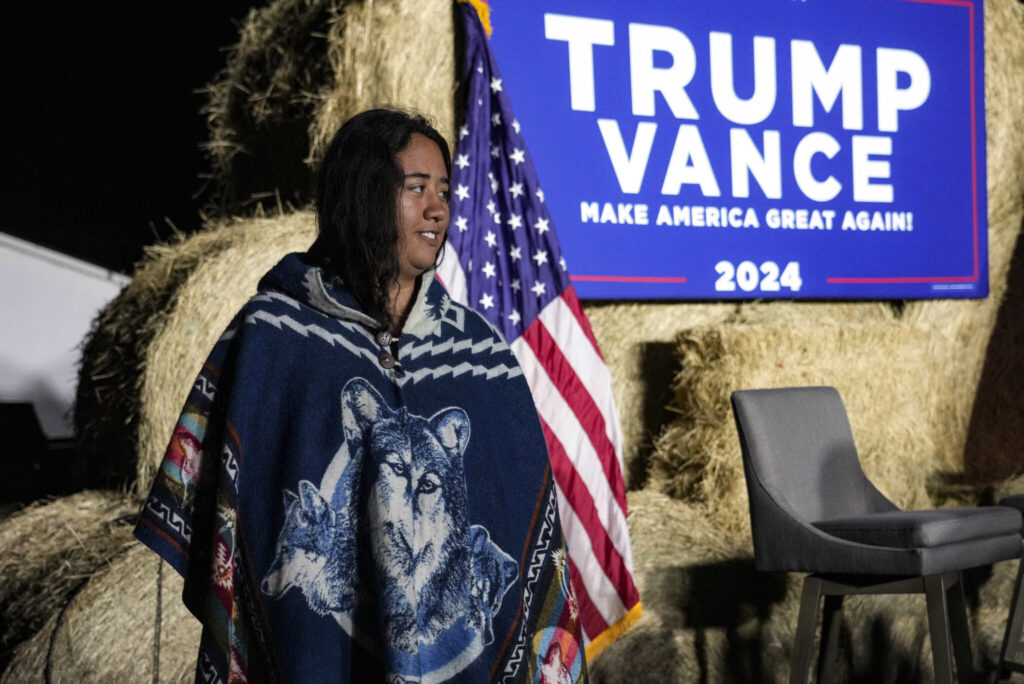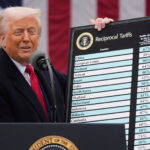Native American voters/ 2024 election/ Kamala Harris/ Trump campaign/ swing states/ tribal sovereignty/ Lumbee Tribe/ Native American voting rights/ environmental protections/ federal recognition/ Newslooks/ RED SPRINGS/ N.C./ J. Mansour/ Morning Edition/ In key swing states, Native American communities could significantly impact the 2024 presidential election. Campaign efforts from both sides seek to mobilize Native voters on issues like land rights, environmental protections, and sovereignty. The contrasting approaches of Trump and Harris reveal different appeals to Native American values and concerns.

Native American Voting Power in 2024 Election Quick Look
- Historical Context: 2024 marks 100 years since the Snyder Act granted Native Americans the right to vote.
- Campaign Outreach: Vice President Harris and the Trump campaign target Native voters, emphasizing different issues.
- Policy Influence: Harris highlights treaty rights and environmental issues, while Trump appeals with economic independence and sovereignty.
- Swing State Impact: Native American voters could sway results in Arizona, North Carolina, Michigan, and Nevada.
- Mixed Reactions: Opinions among Native voters vary, with some embracing Trump’s business-minded approach and others wary of his past actions on land protections.
Native Americans Could Decide 2024 Race for Trump or Harris
Deep Look
Native American communities, granted voting rights a century ago under the 1924 Snyder Act, are gaining attention in the final days of the tight 2024 presidential election, as their influence in critical swing states could prove pivotal for either candidate. Both Vice President Kamala Harris and the Trump campaign are working to mobilize Native voters, though with markedly different messages. Many within these communities are assessing each candidate’s stance on issues like tribal sovereignty, land rights, and environmental protections, which are central to their unique concerns and often differ from broader party agendas.
Targeted Efforts in Key Swing States
Native American voters are being courted intensely in swing states like Arizona, North Carolina, Michigan, and Nevada. Harris’s campaign has run ads and hosted events on tribal lands, drawing on figures like former President Bill Clinton and Donald Trump Jr. to reach these communities. The Democratic campaign emphasizes treaty rights and policies supporting Native American sovereignty, hoping to resonate with concerns about environmental justice and economic opportunity. Notably, Harris has supported a $370 million campaign that includes outreach specifically targeted at reservations, underscoring a commitment to Native American issues.
Conversely, while the Trump campaign has not produced targeted ads, it has enlisted U.S. Senator Markwayne Mullin of Oklahoma, a Cherokee Nation citizen, to engage with Native audiences. The Trump camp is focusing on economic issues and a vision of Native independence from federal oversight, with Mullin stressing how Trump’s policies could enable tribes to maximize their natural resources. This appeal to economic self-determination has garnered support from some Native American voters who see economic growth as essential to improving living conditions within their communities.
Historical and Policy Context
For decades, Native American voters have tended to favor Democratic candidates, but with more variance than other ethnic demographics. According to Gabriel R. Sanchez of the Brookings Institution, Native Americans tend to prioritize issues directly impacting their communities, such as land rights and federal policies concerning environmental protections. The Biden administration’s outreach in 2020 included extensive work in states like Arizona and Wisconsin, where Native precincts contributed to narrow Democratic victories. Building on this, Harris’s current campaign has explicitly promised to honor treaties and strengthen tribal sovereignty, reflecting Obama-era policies that increased Native representation and consultation on federal matters.
While some Democratic promises have left a positive legacy, Trump’s past decisions, like the reduction of Bears Ears National Monument and the reactivation of the Keystone XL pipeline, remain contentious among many Native American leaders and activists. This year, however, Trump has promised that his administration would sign legislation granting the Lumbee Tribe federal recognition—a commitment he shares with Harris, indicating bipartisan acknowledgment of the Lumbee’s push for official status. The Lumbee community, which represents about 55,000 members in North Carolina, remains a focal point, as recognition would grant them access to various federal benefits and autonomy measures reserved for federally recognized tribes.
Sovereignty and Energy Policy Divide
The issue of sovereignty remains critical, with Mullin advocating for energy independence for Native American tribes as part of Trump’s broader “Drill, baby, drill” energy strategy. Mullin argues that the federal government’s oversight of tribal lands restricts economic opportunities, contrasting this policy with private landowners who benefit from resource extraction. Trump’s approach aligns with a free-market vision, one that many tribal advocates worry might compromise environmental protections on Native lands.
This economic sovereignty message has resonated with some, including Robert Chavis Jr., a Lumbee Tribe member and Army veteran. Chavis views the tribe’s governmental authority as akin to a business, and sees Trump’s entrepreneurial approach as beneficial to tribal nations seeking economic stability. However, others within Native communities remain wary of Trump’s past stances on federal land protections and the potential impacts of his environmental policies.
Cultural and Generational Ties to the Democratic Ticket
In Pembroke, North Carolina, Lumbee artist Janice Locklear expressed distrust of Trump’s promises, recalling his unfulfilled commitment to federal recognition in his previous term. Locklear is also troubled by Trump’s alleged efforts to undermine democratic processes, citing the events of January 6, 2021, as a significant concern. Like Locklear, many Native voters connect with Harris’s background and the Biden administration’s history of including Native voices in policymaking roles. The Democratic campaign’s continued focus on racial equality and minority rights has led some to believe that Harris, as a woman of color, may have a deeper empathy for Native issues, such as discrimination and equity in government policy.
In the final days before the election, the spotlight on Native American voters underscores both parties’ recognition of their influence and the evolving role they play in national politics. As Native communities reflect on a century of voting rights, the direction they choose may have profound effects on the 2024 presidential election outcome, underscoring their enduring and growing significance in America’s electoral landscape.







